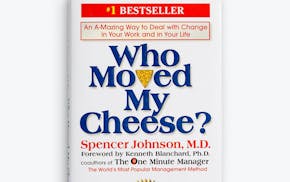If you knew two little words that could improve your sales, you'd use them, wouldn't you?
When you see your customer has some reservations, it makes sense to get the issues out in the open, doesn't it?
After the ink is dry on the deal, you should make every effort to make sure your customer is satisfied, shouldn't you?
Why all the questions? They illustrate a simple technique -- sales tie-downs -- that can help you improve your sales. By getting your customers to agree with you in small steps along the way, you have a better chance of reaching agreement when it's time to do business.
Salespeople who effectively use tie-downs are more successful. It's that simple.
What are sales tie-downs?
They are short phrases that can be added to statements to turn them into questions that get your prospective customer to start saying yes long before you go for the close. You ask these little questions throughout your sales presentation to engage your customers and get them used to saying yes. Psychologically, they will then be more likely to say yes when you ask for the sale.
John Eliason, CEO of First Financial Merchant Services, a credit-card processing firm in Minneapolis, gives the analogy of Gulliver's travels: When Gulliver goes to the land of little people and falls asleep, he wakes up and is tied down to the ground. Gulliver is the sale and all these ropes are the tie-downs.
John says, "If there were only one or two ropes, they would not be strong enough to tie down Gulliver."
Tie-down questions can be as simple as:
Aren't they?
Can't you?
Isn't it?
Shouldn't it?
Won't they?
Perhaps you have been using these questions with your customers all along and didn't know there was a name for this technique.
Tie-downs have to become a natural part of your conversation before you can use them in your sales presentations. Be aware of your tone so the questions don't sound threatening or argumentative. Learning how to use tie-downs effectively takes rehearsal. Practice tie-downs on your spouse or friends. Have some fun using them in role-playing exercises with other sales professionals. That will help you develop a rhythm that will include enough, but not too many, tie-down questions.
Unfortunately, many people in sales don't ask these little tie-down questions, and then lose their customers during their presentations. Give your customers a chance to respond and ask questions of you. Pay close attention to their reactions, because that will lead you to your next tie-down.
Most often, salespeople use tie-downs at the end of sentences, but they can be used at the beginning of a sentence. For example, if you are selling an alarm system you might ask: Isn't it important for your family to have peace of mind?
A lot of sales are based on price. You might ask customers: Saving money is important to you, isn't it? If I could show you a way to save, is that important to you?
Another benefit of using sales tie-downs it that you don't need a big close, as many sales representatives believe. You risk losing your customer when you save all the good stuff for the end. Keep the customer actively involved throughout your presentation, and watch your results improve.
Now let me ask you again: If you knew two little words that could improve your sales, you'd use them, wouldn't you? I think you know the answer.
Mackay's Moral: Use sales tie-downs to lasso more customers.
Harvey Mackay is a Minneapolis businessman. Contact him at 612-378-6202 or e-mail harvey@mackay.com.
Mackay: Approach AI with a mindset of collaboration rather than fear

Mackay: The key to winning in sports, business and life is practice

Mackay: Humor can make even dire situations bearable

Mackay: Want a raise? How and when you ask for it matter

